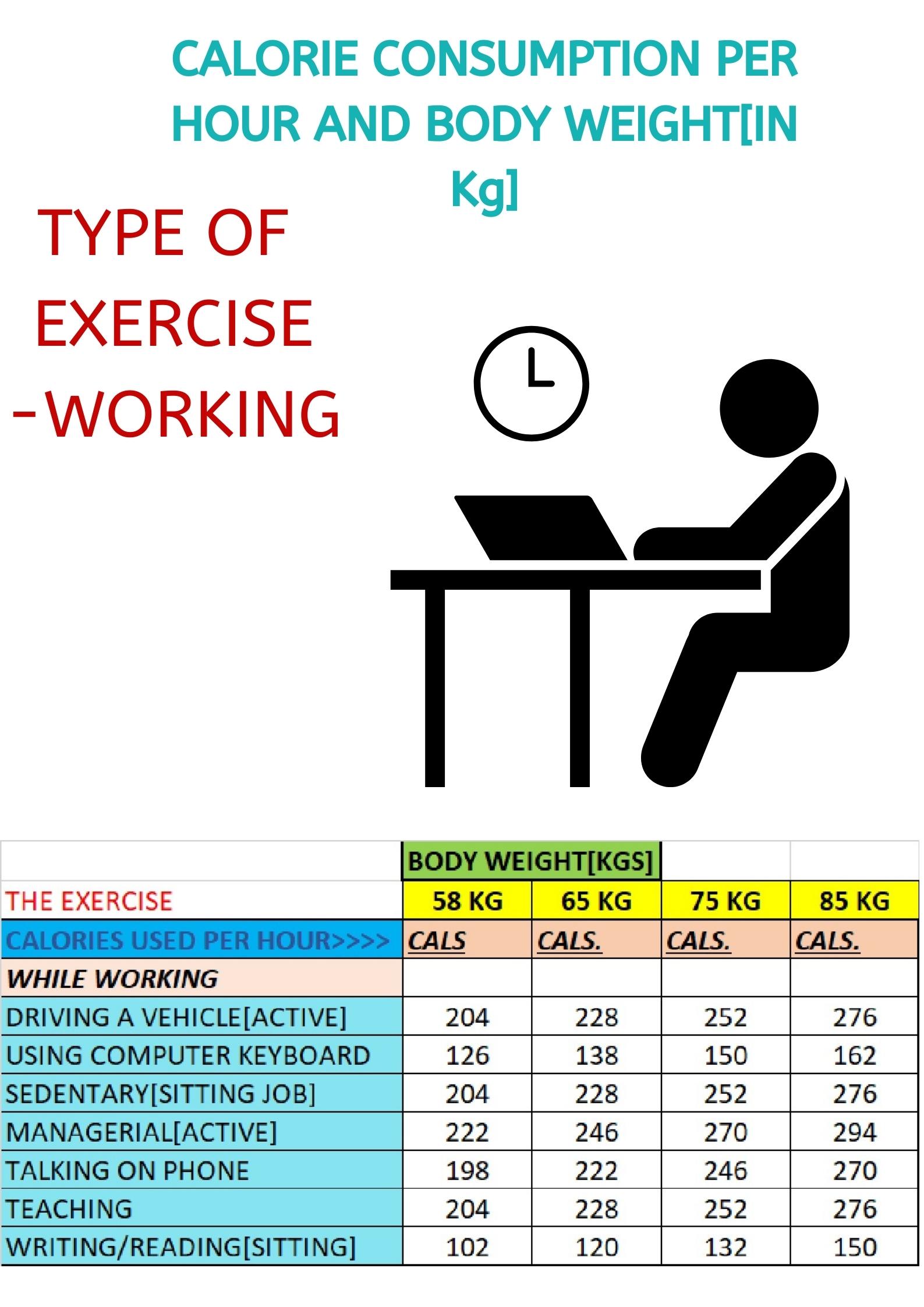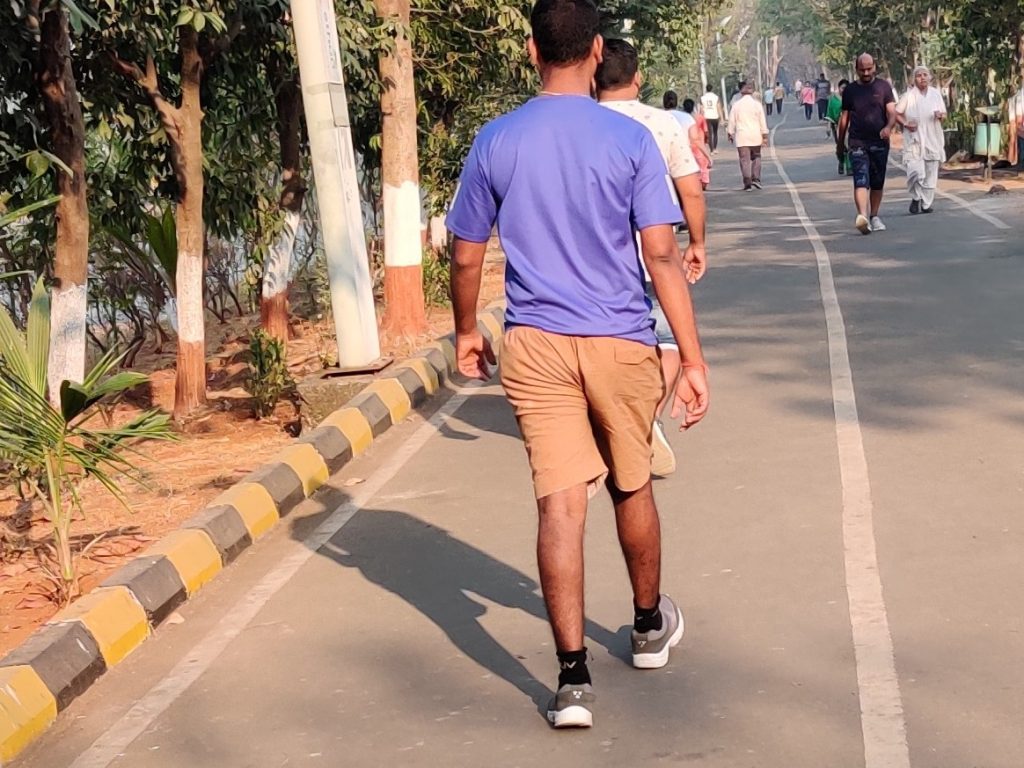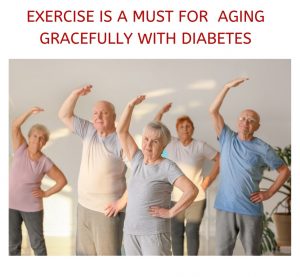Table of Contents
Introduction
Tip No.1 For Aging Gracefully with Diabetes-Exercise
In my last article, I discussed the different complications of Diabetes and its effect on aging. Now, let us come back to tips to aging gracefully with diabetes.
Exercise is the Number One tip I recommend to all my senior citizen patients. This article is not necessarily only for the diabetic aged– it will benefit others without diabetes as well.
What are the different types of exercises?
In our busy day-to-day life, getting time to have a workout is becoming difficult. However, keeping in mind the benefits a workout has on our health, I recommend these forms of exercises for everyone, and more specifically, to the elderly-
1. Outdoor exercise –
such as walking 🚶♀️, jogging, running 🏃♂️, tennis, football, cycling, swimming, etc. Here is an interesting article that proves the benefits of walking.
2. Indoor exercise-
Working out in a gym 💪, Badminton 🏸, table tennis 🏓, indoor cycling, swimming, etc.
3. High-Intensity Interval Training( HIIT)-
This can be either outdoors or indoors. HIIT consists of a series of intense exercises performed over a short period of time with minimal breaks. To know more about HIIT, click this link.
Here is a video about one of the low impact HIIT for the elderly-
Even though the exercises shown in the above video are extensive, you need not do all the exercises all at once in those stipulated 30 odd minutes. Depending upon your physical and status of your heart health[ cardiac status], you may do the exercises in batches to suit your health.
One of the largest randomized controlled trials of HIIT, published last year in BMJ Open, suggests that healthy people in their 70s can do these workouts with little risk. But in terms of longevity, moderate-intensity exercise seems to be just as good.
Source- Harvard Health Education
4. Yoga 🧘♂️
Yoga is a form of exercise that helps us to concentrate, thereby maintaining mind and body balance. Yoga is best suited for overweight and obese diabetic elderly patients. Doing yoga helps by-
- Decreasing fasting insulin levels, thereby normalzing insulin to glucose ratio;
- reduction in free fatty acid levels which happens in diabetes because of utilization of insulin in the periphery like in muscles, brain and other important organs;
- reduce insulin resistance;
- improve insulin sensitivity;
- reduces drug requirement.
Here is a good video showing how to do yoga to manage diabetes. This will certainly help control your diabetes thereby adding years to your age!
5. Tai- chi
Tai-chi is an exercise that helps in maintaining a balance in our body. As we age, due to various reasons, we tend to lose balance. According to Peter M.Wayne, author of the book-The Harvard Medical School Guide to Tai Chi– tai chi is a form of exercise “for improving health in our aging population; for eg., by preventing heart disease and fall-related fractures”. Tai Chi is a vast subject, similar to Yoga and is being practiced mostly in the far east countries like Japan and China. According to Peter Wayne,
Tai Chi is a mind-body exercise rooted in multiple Asian traditions, including martial arts, traditional Chinese medicine, and phyilosophy. Tai Chi training integrates slow, intentional movements with breathing and cognitive skills
Peter M.Wayne
Walking- The No.1 Best Exercise for All
Among exercises, I consider walking 🚶♂️ to be the best exercise.

Scientific research shows that walking anywhere between 7000 to 10000 steps per day is highly beneficial for aging gracefully, with or without diabetes. This article in New York Times shows how walking will help you live longer and healthy.
What exactly happens when you exercise? And how it helps in diabetes?
When we work out, energy is spent in the form of heat, which we measure in calories. This energy we derive from glucose which circulates in the blood. Your muscles take up all the glucose in your blood to work, creating a deficit. This helps in bringing blood glucose under control. Here is one article where I have discussed both – the exercise as well as the calories lost that has an impact on blood sugar levels.
Now, in a younger person, where there is good metabolic control, any form of workout, for example, walking, running, jogging, high-intensity interval training[HIIT], etc., will do.
But in the middle-aged and elderly /older individuals having diabetes, there is gradual loss of muscle mass, degeneration of joints, bones, etc., which leads to disuse. As shown in the video above, a low impact HIIT will help the senior citizens, especially those with diabetes, to maintain-
- Joint mobilty
- Muscle mass
- Body balance
- Blood sugar levels
Care to take while doing HIIT
While starting these HIIT workouts, start slow, do not rush and there is no need to do all the exercises shown in your early days. Do it one at a time, taking about 5 minutes or less, and then scale up as you become comfortable with these exercises. I am sure, in the coming days, you’ll feel more energetic and will be able to enjoy aging gracefully.
Remember one thing while you exercise- you are doing it to keep your heart and brain healthy. As we age, our heart and brain health tends to decline. If you have been recently diagnosed with either heart or memory problem, do consult your family physician before starting any form of HIIT or workout.
How to start HIIT-
It is always better to do exercise that you love doing. At the same time, there are a few basics you should know to help your aging heart. Follow the method of calculating your maximum heart rate ( MHR)for your age. How to calculate this? Just follow this step- your maximum heart rate should be 220 minus your age. For eg., if you are 60 years old, it will be 220-60=160. Normally, your heart rate is 70 to 90 beats per minute.
HIIT aims at giving exercise to your body ( and thereby, your heart) at short bursts of high intensity and low intensity. Let’s say you are walking. You can walk at a high speed (brisk walks) for 5 minutes. During this period your target heart rate should be 85% of your maximum heart rate. While slowing down, it should be 60% of the MHR. This way you can adjust the time and exercise to suit your heart health.
Elderly people are a bit skeptical about doing hard exercises. These people need to be encouraged to exercise regularly, so that they improve muscle mass, make their bones strong by improving calcium uptake by the bones, and keep their joints supple.
Working out in the open
Additionally, exercising in sunlight will also give your body the much-needed Vitamin D3[ read this article to know exactly how. ]
This helps in maintaining bone health as well as improving the function of many other organs in our body.
If exposure to sunlight is a problem, you can consider taking oral Vitamin D3.
What about bloodsugar levels in the elderly diabetics?
To overcome this deficit, the body has regulators in the form of hormones. These hormones are produced mostly by the pancreas- a gland in our abdomen. During exercise, these hormone levels fluctuate to adjust the blood sugar in such a way that there should be no cause for worries, like say, getting hypoglycemia.
Exercise and its relation to Hormones that regulate blood sugar-
These are the few hormones that regulate blood sugar in both non-diabetic and diabetic people.
They are-
- Insulin
- Glucagon
- Somatostatin
- Pancreatic polypeptide
- Amylin
Each hormone has its role cut out to regulate blood sugar.
To know how they do this, I have written a separate article- read here-
Precautions while exercising-
As an aging elderly with diabetes, there is a high probability of falls while exercising, mostly due to
- aging joints,
- poor vision
- Poor hearing
- Loss of spatial orientation, for eg., losing balance.
Read this article for details on how to prevent falls- 7 tips to prevent falls in the elderly
Advantages of Exercising-
- Exercise keeps your joints supple and prevents age-related arthritis like Osteoarthritis.
- It helps to burn fats if you are overweight or obese.
- Here is one more article to help you age gracefully-link
If you have not already read my previous blog, you can click on the article below to read it-
Conclusion:-
I hope you have enjoyed reading this article on how exercise helps you in aging gracefully. In my next article, I will be discussing the second-best tip- Diet To help you in aging gracefully with diabetes.
Finally, I would be glad if you sign up for my newsletter so that you have the latest article in your inbox as and when I publish one.
Subscribe
Thank you for subscribing!



